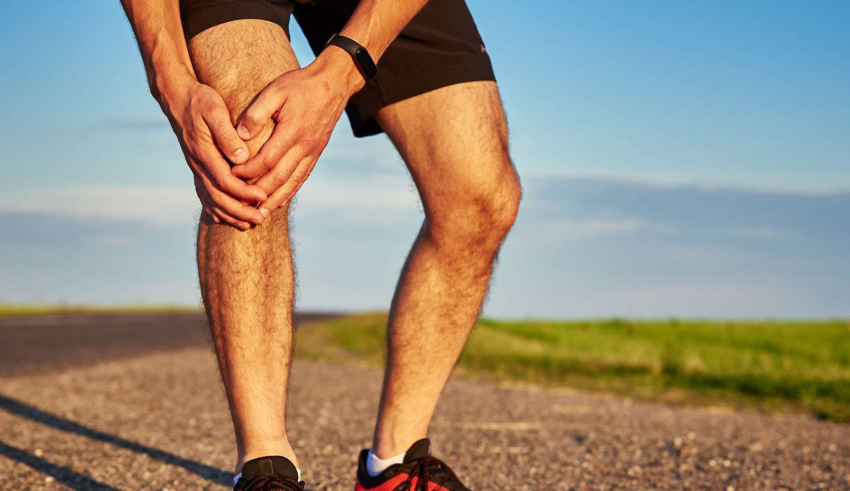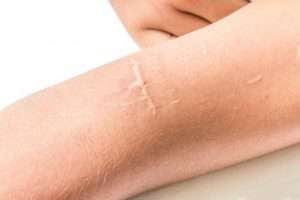
No matter how cautious we are, accidents happen. Whether it’s a child banging his head against the sharp corner of a coffee table or an adult slipping up with a kitchen knife while chopping vegetables, injuries can occur. As your skin recovers, a scar may form – a natural part of the healing process. If you’re wondering about ways to lower your chances of developing a scar after an injury, read this article in collaboration with the dermatologist Dr. Eman Soliman, who will offer some tips for reducing the appearance of scars from wounds.
How do scars normally form?
Scar formation is part of the body’s natural healing process when tissue is damaged.
When the skin is injured, the tissue breaks down, causing the release of a protein called collagen. Collagen accumulates at the site of tissue damage, helping to heal and strengthen the wound.
New collagen continues to form for several months and the blood supply increases, causing the scar to lift and become lumpy.
Over time, some of the collagen breaks down at the wound site and the blood supply decreases. The scar becomes progressively smoother and softer.
Shallow cuts and superficial wounds that affect only the top layer of the skin usually do not leave scars. Dr. Eman Soliman says that scars sometimes fade over time, even without treatment.
What types of scars can form after an injury?
The first thing to know is that scarring is a normal part of the healing process. According to Dr. Eman Soliman, the size of the scar depends on the size of the wound.
A scar can be a fine line or punctured hole in the skin, or abnormal growth of tissue. Four types of scars can form after an injury:
1- Hypertrophic scars. Hypertrophic scars protrude from your skin. They usually have a red appearance and do not extend beyond the boundaries of the original injury. A hypertrophic scar occurs when too much collagen is produced at the site of the injury.
2- Keloid scars. Keloid scars protrude from the skin and extend beyond the original injury. Like hypertrophic scars, keloid scars are the result of excess collagen produced at the site of a wound.
3- Acne scars. All types of acne are likely to leave superficial or deep scars.
4- Contracture scars. This type of scarring is usually caused by a burn. Contracture scars cause the skin to tighten, which can limit joint movement.
How to avoid scars from wounds?
The appearance of a scar frequently depends on how well the wound has healed. There are measures you can take – and mistakes you can avoid – to help heal the skin with as little residual scarring as possible. Dr. Eman Soliman affirms that you minimize your chances of developing scars from wounds by following good first aid habits.
Here’s how to do it:
1- Treat wounds immediately. It is impossible to completely eliminate scarring when healing old wounds. Thus, you can give your wound the best chance to heal without scarring by treating it immediately with first aid. Serious injuries may require stitches and need the attention of a medical professional.
2- Keep your wound clean. Cleaning your wound daily with mild soap and water can help keep your wound clean and remove debris accumulation. You can also cleanse your wound using an antiseptic spray instead of soap and water.
Ducray Diaseptyl Spray: This is an antiseptic spray that is effective against a wide range of microorganisms. It cleanses the skin easily and instantly, without causing pain or further damage to the skin. This product is suitable for babies, children and adults, thanks to its simple and well-tolerated composition, which contains no alcohol or dyes.
3- Apply a wound scar cream. Dr. Eman Soliman recommends applying a scar cream after 3 days of the wound. She adds that the scar removal cream should contain honey extract, silicon, a topical antibiotic and it is best if it is in gel form.
A wound scar cream promotes rapid and aesthetic skin repair, helps reduce the appearance of skin marks, and provides instant and lasting relief from unpleasant skin sensations. It also helps protect the skin from external aggressors while maintaining adequate moisture for optimal skin restoration.
Below are some of the best options for scar creams available for purchase.
For non-oozing wounds:
A-Derma Epitheliale A.H Ultra Soothing Repairing Cream
Eau Thermale Avène Cicalfate+ Restorative Protective Cream
For oozing wounds:
If your wound is oozing, you should start with a drying lotion that dries and decongests the area. Once it is dry, you can follow up with the creams mentioned above.
A-Derma Cytelium Drying Spray
4- Cover your wound. Covering your cut with a bandage will protect it from injury and infection.
5- Change your bandage every day. By changing your dressing every day, you can keep your wound clean and monitor its healing.
6- Do not touch the scabs. Dr. Eman Soliman advises avoiding scratching or picking at the scabs. This can help reduce irritation and bleeding. Scratching or touching your scabs can also introduce bacteria that can cause infection.
7- Seek medical attention for deep cuts or severe injuries. If your wound is particularly deep or large, it’s a good idea to see a doctor for advice on how best to deal with it.
8- Follow the doctor’s recommendations for stitches. If your wound requires stitches, it’s advisable to follow your doctor’s recommendations on how to treat it.
How can I prevent scarring after a scab falls off?
Cuts and scrapes take longer to heal if scab forms. When the scab falls off, it is advisable to follow the same protocol as for other types of wounds. Try to avoid touching the pink wound under the scab and keep it bandaged to avoid irritation and infection.
What personal factors affect wound healing?
The following factors affect wound healing:
- Genetics. How you heal depends a lot on your genetics. For example, dark skin can produce darker, thicker scars.
- Certain diseases such as diabetes, thyroid disease, high blood pressure, and poor circulation can decrease the body’s ability to heal.
- Diet – Studies show that your body needs certain vitamins and minerals to heal effectively.
- Your age – Younger people generally recover more easily than older people, but older people’s scars fade more quickly.
- Non-smokers, on average, heal faster than smokers.
- The quality of the skin and the blood supply to the area.
Keep an eye, not a hand, on your scar
Monitoring scars from wounds will help you track its progress and detect any problems early, but you should avoid touching the area unnecessarily. Do what you can to keep the area clean and dry, but make sure to sterilize your hands before applying any recommended creams or gels. Since every scar is different, make sure you follow the specific advice given by your doctor.
The best way to improve your chances of getting a good result is to start with healthy skin. Vitamins C, E, zinc, and B are all very good for the skin, not only in creams but also in your diet. Make sure to fill up on these vitamins during the healing process, and keep your scar away from the sun as exposure to UV rays can cause pigmentation problems. Remember healthy skin, healthy scars.
For many people, scars can be a source of anxiety. You may worry that a scar won’t heal fast enough, or that it’s more serious than you think. But by following our guide, you can reduce the appearance of scars after wound healing.













